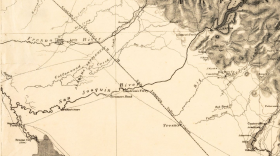They were once a common and iconic part of the Central Valley landscape, but they’re growing increasingly rare. Today on KVPR’s Central Valley Roots, the story of the tankhouse – a key technology that made the valley bloom, over 100 years ago.
Drive through the rural areas on the east side of the Valley and chances are at some point you’ll come across an old farmhouse from the 19th century. In many cases, you’ll see an odd shaped outbuilding, shaped kind of like a giant wooden milk carton, two or three stories tall. Some have sloping walls at the base, while others are boxy rectangles. They’re known as tankhouses, and while they can be found in places ranging from Texas to the Northwest, they’re especially identified with California, and the Central Valley.
The earliest tankhouses were likely built in the 1860s and combined a water well, water pumping and water storage in one system. These were hi-tech devices of their day. A typical tankhouse had a sturdy wood frame and held up a large water tank on the top floor, from 2,000 to 10,000 gallons. It also would have had a self-regulating windmill, either mounted on the tower or next to it. These devices would automatically turn to capture the wind and regulated their speed in high winds for safety.
The windmill would power a pump, which lifted water from the aquifer to the tank, 20 to 30 feet in the air, which was enough to supply gravity produced water pressure. The space below the tank was enclosed with redwood siding, forming extra rooms for storage or even housing. Beginning in the 1890s, small gasoline engines were used to supplement the wind. But by 1935, the tankhouse was essentially obsolete, replaced by electricity and modern pump technology. And while they’re increasingly rare today, with many succumbing lack of maintenance or urbanization, the ones that remain are striking reminder of Valley life a century ago.






